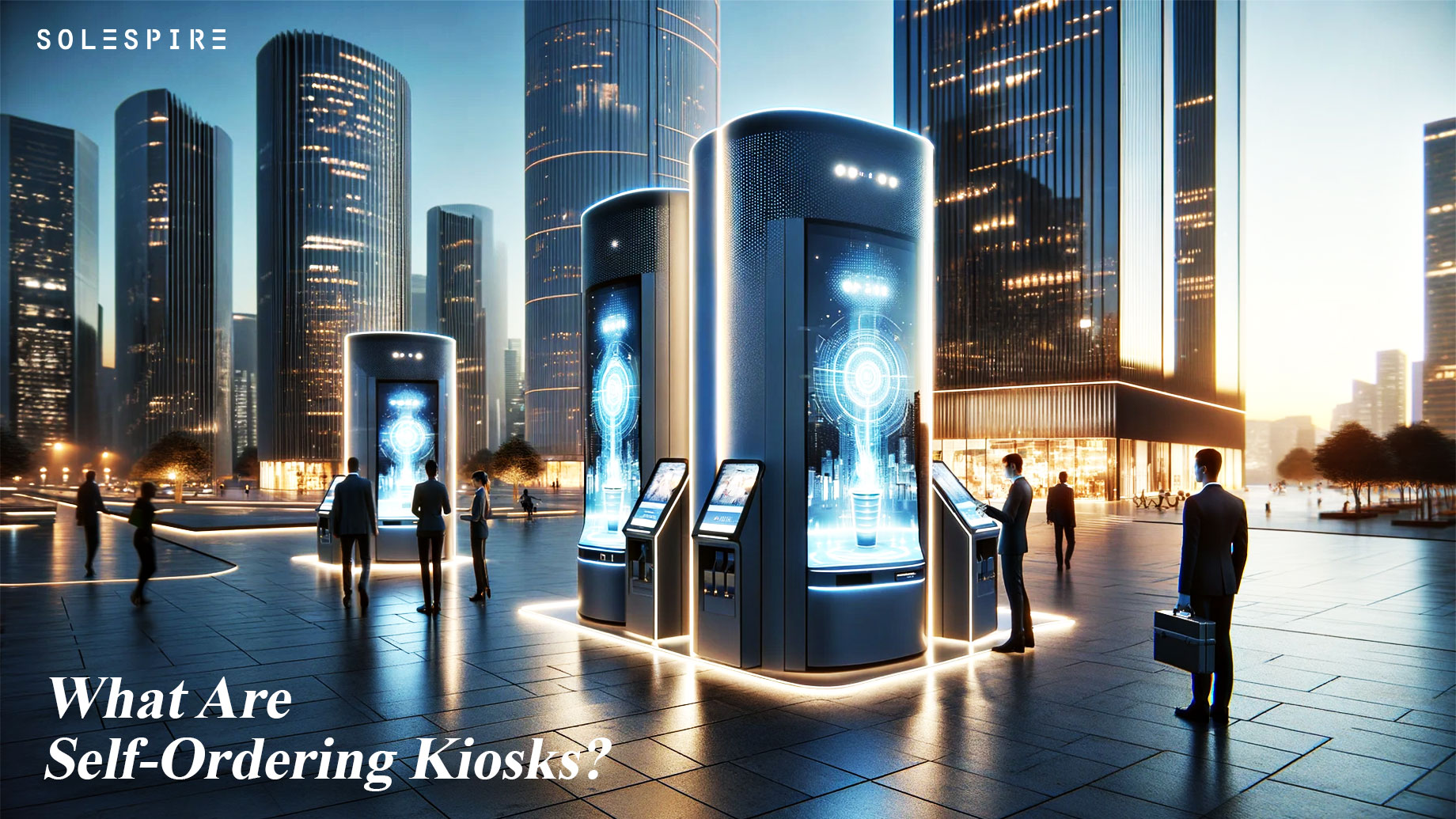
Self-ordering kiosks have become a common sight in various industries, offering a convenient and efficient way for customers to place their orders. These user-friendly digital interfaces are revolutionizing the way businesses interact with their customers, providing a seamless and personalized experience.
In this article, we will delve into the workings of self-ordering kiosks, exploring their benefits, different types, and their use across various industries. We’ll also address security concerns and future trends, providing valuable insights for businesses looking to integrate this technology. So, let’s explore the world of self-ordering kiosks and discover how they are reshaping the customer service landscape.
Key Takeaways:
- Self-ordering kiosks are automated machines that allow customers to place orders and pay for products or services without assistance from a staff member.
- These kiosks offer numerous benefits, such as increased efficiency, improved accuracy, and enhanced customer experience for businesses.
- Self-ordering kiosks are utilized in various industries, such as fast food restaurants, retail stores, movie theaters, airports, and hotels, and have increasingly become popular in recent years.
What Is A Self-Ordering Kiosk?
A self-ordering kiosk is an automated system that allows customers to place their orders for food or services independently at a restaurant or business.
These kiosks are designed to streamline the ordering process, providing customers with an intuitive interface to browse menu items, customize their orders, and make secure payments using various options such as cash, credit/debit cards, or mobile payment apps. Self-ordering kiosks offer convenience and efficiency, reducing wait times and enhancing the overall customer experience.
They also enable businesses to manage peak hours more effectively, optimize staff allocation, and improve order accuracy. The interactive nature of self-ordering kiosks gives power to customers, giving them greater control over their experience while freeing up staff to focus on delivering exceptional service and hospitality.
How Does A Self-Ordering Kiosk Work?
A self-ordering kiosk operates by providing customers with a user-friendly interface to select menu items, customize orders, and securely submit their preferences for food or services at a restaurant or self-service establishment.
Upon approaching the kiosk, customers are greeted by a visually engaging display that presents the menu offerings in a clear and organized manner, often categorized by food type or meal options. By interacting with the touchscreen interface, users can effortlessly browse through the available selections, view detailed descriptions, and even access nutritional information for well-considered choices.
The kiosk gives patrons the ability to customize orders according to their specific preferences. Whether it’s modifying ingredients, portion sizes, or special dietary requirements, the intuitive interface facilitates seamless personalization, ensuring that each order aligns with the individual’s taste and dietary needs.
Once the selections are finalized, the submission process involves a series of user-friendly prompts that guide customers through the secure submission of their orders. Payment options, including cash, card, or digital wallets, are seamlessly integrated into the interface, offering convenience and flexibility.
What Are The Benefits Of Using A Self-Ordering Kiosk?
Implementing self-ordering kiosks offers several benefits for businesses, including increased efficiency, improved accuracy, and enhanced customer experience.
Increased Efficiency
Self-ordering kiosks significantly enhance operational efficiency by streamlining the order placement process, reducing wait times, and optimizing resource allocation for businesses in the restaurant industry.
The order processing speed at self-ordering kiosks is notably faster than traditional manual methods, allowing customers to place their orders swiftly and accurately. This not only reduces wait times for customers but also contributes to the overall throughput of the establishment.
The optimized resource allocation ensures that staff can be deployed more effectively, enabling them to focus on tasks that directly impact service quality and customer satisfaction. This efficient operating model translates to improved business operations and enhanced customer experiences.
Improved Accuracy
The use of self-ordering kiosks ensures improved order accuracy, minimizes errors in customer preferences, and enhances overall satisfaction at restaurants or food service establishments.
By allowing customers to input their orders directly, self-ordering kiosks mitigate the chances of misunderstandings or miscommunications that can occur when orders are taken by human staff. This leads to a reduction in order errors and ensures that customers receive precisely what they requested. These kiosks provide an advanced level of order customization, allowing patrons to tailor their orders with specific dietary preferences or modifications, thereby enhancing the overall precision and personalization of the ordering process.
As a result, the implementation of self-ordering kiosks results in heightened customer satisfaction, as individuals receive orders that align more closely with their preferences. This improved satisfaction further contributes to an enhanced dining experience, positively impacting the overall quality of service and customer relations for food service establishments.
Enhanced Customer Experience
Self-ordering kiosks contribute to an enhanced customer experience by giving individuals the power to conveniently place their orders, customize their preferences, and enjoy a seamless service process at restaurants or food service outlets.
The convenience offered by self-ordering kiosks not only streamlines the overall ordering process but also provides customers with a sense of control and autonomy. With the ability to customize their orders, patrons can tailor their meals to their specific preferences, leading to a higher level of satisfaction.
The interactive nature of self-ordering kiosks engages customers in a unique way, enhancing their overall dining experience through technology-driven service enhancements.
What Are The Different Types Of Self-Ordering Kiosks?
Self-ordering kiosks come in various types, including standalone kiosks, tabletop kiosks, and mobile kiosks, each designed to cater to diverse customer preferences and operational needs.
Standalone kiosks are freestanding units ideal for high-traffic areas, offering a robust and durable design. Tabletop kiosks, on the other hand, provide a space-saving solution for smaller establishments, allowing customers to conveniently place their orders while seated. Mobile kiosks, with their flexibility and portability, serve well in settings where customers prefer to order from their own devices, providing a seamless, user-friendly interface.
Standalone Kiosks
Standalone kiosks operate as independent order placement stations, offering customers a dedicated interface to place their orders and customize their preferences in various service-oriented environments.
These kiosks provide customers with a seamless and personalized ordering experience, allowing them to browse through menu options, select items, and make specific modifications according to their preferences.
The user-friendly interface of standalone kiosks is designed to simplify the ordering process and reduce wait times, enhancing overall customer satisfaction.
The streamlined nature of these kiosks ensures efficient order processing, contributing to improved operational efficiency for businesses.
Tabletop Kiosks
Tabletop kiosks are designed to facilitate order placement and customization directly at the customer’s table, providing a convenient and interactive dining experience in various food service establishments.
By allowing patrons to browse the menu, place their orders, and even make special requests or customizations at their convenience, these kiosks significantly enhance the overall dining experience. The interactive interfaces not only streamline the ordering process, but also provide helpful descriptions and visuals of menu items, assisting customers in making informed choices.
Tabletop kiosks contribute to improved efficiency and accuracy in order taking, translating to faster service and reduced errors. From the restaurant’s perspective, this integration can enhance customer engagement and satisfaction, potentially leading to increased sales and loyalty.
Mobile Kiosks
Mobile kiosks offer customers the flexibility to place orders and customize preferences using handheld devices, enabling efficient service delivery and personalized experiences across diverse food service and retail environments.
These innovative platforms are designed to provide a seamless and convenient way for customers to interact with businesses, whether in busy malls, airports, or events. The portability of mobile kiosks ensures that they can be easily moved to high-traffic areas, enhancing visibility and accessibility for customers.
What sets mobile kiosks apart is their customization options, allowing businesses to tailor the interface and offerings to meet specific customer needs. This level of personalization helps in creating a more engaging and delightful customer experience, promoting brand loyalty and satisfaction.
The integration of mobile kiosks significantly impacts customer convenience by reducing wait times and streamlining the ordering process. Customers can browse menu items, make selections, and complete transactions with ease, ultimately leading to improved operational efficiency and customer satisfaction.
What Industries Use Self-Ordering Kiosks?
Self-ordering kiosks are widely adopted across various industries, including fast food restaurants, retail stores, movie theaters, airports, and hotels, to streamline customer ordering processes and enhance operational efficiency.
Fast Food Restaurants
Fast food restaurants leverage self-ordering kiosks to expedite order placement, minimize wait times, and offer customers a convenient and customizable dining experience tailored to their preferences.
This technology has revolutionized the way customers interact with fast-food establishments. With the ability to browse the menu, customize their orders, and pay directly through the kiosk, patrons can enjoy a streamlined and efficient ordering process.
Self-ordering kiosks have been instrumental in reducing errors in order accuracy, leading to increased customer satisfaction. The integration of these kiosks has also enabled fast-food restaurants to reallocate staff to other roles, thereby enhancing operational efficiency and reducing labor costs.
Retail Stores
Retail stores implement self-ordering kiosks to facilitate seamless product selection, customization, and checkout processes, enhancing the overall shopping experience and operational productivity for customers.
These interactive kiosks give customers the power to browse through an extensive range of products, providing detailed information about each item. The self-ordering kiosks further enable customers to customize their purchases, such as selecting size and color or adding personalized features, allowing for a tailored shopping experience.
These kiosks contribute to enhancing customer engagement by offering recommendations based on previous purchases or popular products. They also play a crucial role in improving operational efficiency by reducing wait times, streamlining the checkout process, and minimizing potential errors related to traditional manual ordering.
Movie Theaters
Movie theaters employ self-ordering kiosks to streamline ticket and concession purchases, offering patrons a convenient and efficient experience for ordering snacks, beverages, and film tickets.
These self-ordering kiosks have revolutionized the traditional movie-going experience by reducing wait times and providing a seamless transaction process. Customers can now skip long lines at the box office and concession stand, allowing them to enjoy more time for their movie-going experience.
These kiosks offer a user-friendly interface, enabling patrons to customize their orders with ease, leading to increased customer satisfaction and improved overall customer service. The integration of self-ordering kiosks in theater environments has not only improved operational efficiency but also enhanced the overall cinematic experience for movie enthusiasts.”
Airports
Airports integrate self-ordering kiosks to enhance the efficiency of food and beverage services, providing travelers with quick and customizable dining options to accommodate their schedules and preferences during their journeys.
These kiosks streamline the ordering process, reduce wait times, and allow passengers to pre-order meals, ultimately enhancing passenger convenience and satisfaction. The implementation of self-ordering kiosks contributes to operational efficiencies for airport businesses by optimizing staff resources and improving order accuracy, leading to smoother operations and reduced congestion in dining areas.
As travel industry trends increasingly emphasize personalized experiences and efficient services, these kiosks align with the evolving expectations of travelers, offering a seamless and tech-savvy dining experience within the airport environment.
Hotels
Hotels utilize self-ordering kiosks to offer guests personalized dining experiences, room service selections, and amenities, enhancing the overall hospitality service and guest satisfaction throughout their stay.
These intuitive kiosks enable guests to conveniently place orders, customize meals, and make special requests, all while providing a seamless, hassle-free experience. This technology not only streamlines the ordering process but also gives guests the power to tailor their dining preferences, contributing to enhanced guest satisfaction.
The presence of self-ordering kiosks enhances operational efficiency, reducing waiting times and potential order errors, thus allowing hotel staff to focus on delivering personalized, high-quality service.
What Are The Security Concerns With Self-Ordering Kiosks?
The use of self-ordering kiosks raises security concerns related to the protection of customer information, order data, and payment details within business and service environments.
While these kiosks offer convenience and efficiency, the collection of sensitive customer data also requires robust data protection measures to safeguard against potential cyber threats. Implementing encrypted data transmission, secure payment processing, and regular software updates can help mitigate the risk of unauthorized access to customer data.
Businesses must prioritize privacy measures to ensure compliance with regulations such as GDPR and CCPA, thereby earning customer trust and loyalty. Deployment of advanced fraud prevention technologies is essential to detect and prevent fraudulent activities, safeguarding both the business and its customers against potential security breaches.
How Can Businesses Ensure The Safety Of Customer Information On Self-Ordering Kiosks?
Businesses can safeguard the confidentiality and integrity of customer information on self-ordering kiosks by implementing robust encryption protocols, regular security audits, and compliance with data protection regulations.
These measures are crucial in preventing unauthorized access and data breaches, ensuring that sensitive customer data remains secure and protected. Encryption plays a pivotal role in rendering the data unreadable to unauthorized parties, making it a fundamental layer of defense. Concurrently, conducting regular security audits enables businesses to identify vulnerabilities and gaps in their kiosk systems, allowing for timely remediation and reinforcement of security measures.
Adherence to data protection regulations such as GDPR or CCPA is imperative to maintain a legal and ethical stance in handling customer data. This not only builds trust with consumers but also shields businesses from potential legal ramifications. A holistic approach towards data security on self-ordering kiosks elevates customer confidence and establishes a strong foundation for sustainable business operations.
Advanced Solutions in Kiosk Technology: AirDroid Business Kiosk Mode
As businesses continue to embrace self-ordering kiosks, the demand for advanced management and security solutions becomes increasingly critical. A notable development in this arena is the AirDroid Business Kiosk Mode. This technology is specifically designed to enhance the functionality and security of Android-based kiosks.
Key Advantages of AirDroid Business Kiosk Mode
- Enhanced Device Management: AirDroid Business Kiosk Mode allows IT administrators to lock Android tablets into single or multi-app modes. This feature is particularly beneficial for businesses that want to limit device usage to specific applications, thereby preventing misuse and ensuring devices are used solely for their intended purpose.
- Customizable User Experience: The software offers customization options, including setting the device layout with a custom logo, wallpaper, and icon sizes. This flexibility allows businesses to tailor the user interface to align with their brand identity and user experience goals.
- Improved Security: With features like website whitelisting and built-in incognito mode, AirDroid Business Kiosk Mode ensures a safe browsing experience. This is crucial for kiosks used in public spaces, as it protects against unauthorized network access and secures customer data.
- Application Across Industries: This technology caters to various industries, including education, logistics, and retail. For instance, in schools, it can limit access to educational apps and services, enhancing the learning experience. In logistics, it helps drivers focus on essential tasks by restricting access to company apps. In retail, it simplifies usage for non-tech-savvy employees and enhances customer interactions with branded content.
- Addressing Workplace Challenges: AirDroid Business Kiosk Mode not only secures devices but also addresses common workplace challenges. It helps manage rising IT support requests, reduces distractions caused by non-work-related apps, and provides necessary protections against security risks.
For businesses interested in exploring this solution, AirDroid offers a free trial, allowing companies to try all features without any additional setup fees. Additionally, businesses can schedule a demo to see how this technology can be tailored to their specific needs. More information can be found at AirDroid Business Kiosk Lockdown Software.
By integrating solutions like AirDroid Business Kiosk Mode, businesses can further enhance the efficiency, security, and user experience of their self-ordering kiosks, ensuring they stay at the forefront of this rapidly evolving technology.
What Are The Future Trends For Self-Ordering Kiosks?
The future trends for self-ordering kiosks revolve around advanced technologies, such as AI-driven customization, seamless integrations with mobile platforms, and enhanced customer-centric features to further elevate the self-service ordering experience.
AI integration is likely to play a pivotal role in simplifying the ordering process, providing personalized recommendations based on past preferences and behaviors. The integration with mobile platforms will enable customers to place orders conveniently from their smartphones, reducing waiting times and enhancing overall convenience.
Customer-centric enhancements could include interactive touchscreens, voice recognition, and even facial recognition technologies, creating more personalized and efficient experiences.
Frequently Asked Questions
What is a Self-Ordering Kiosk?
A self-ordering kiosk is a touchscreen device that allows customers to place their own orders without the need for a cashier or server.
How does a Self-Ordering Kiosk work?
A self-ordering kiosk works by displaying a menu of items on a touch screen. Customers can browse and select their desired items, customize their order, and pay for their meal all through the kiosk.
What are the benefits of using a Self-Ordering Kiosk?
There are several benefits of using a self-ordering kiosk, including faster service, increased order accuracy, and reduced labor costs for businesses.
Are Self-Ordering Kiosks only for fast food restaurants?
No, self-ordering kiosks are becoming increasingly popular in a variety of industries, including fast-casual restaurants, coffee shops, and even retail stores.
Do I need to have any special skills to use a Self-Ordering Kiosk?
No, anyone can use a self-ordering kiosk. The touchscreen interface is user-friendly and simple to navigate, making it accessible to all customers.
Can I still interact with a server or cashier if I use a Self-Ordering Kiosk?
Yes, most self-ordering kiosks still have the option for customers to interact with a server or cashier if they have any questions or need assistance with their order.

